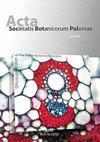Polish Cryobanks: Research and Conservation of Plant Genetic Resources
IF 1.1
4区 生物学
Q3 PLANT SCIENCES
引用次数: 4
Abstract
To date, the use of liquid nitrogen (LN) in plant gene banks is relatively limited. Globally, in 2021, approximately 10,000 accessions were cryopreserved, and their explants were derived from in vitro plants. In Europe, out of 500 banks, only 20 use cryogenic temperatures to store plant germplasms. The implementation of seven conservation projects in Poland starting in the 1990s meant that the gene banking system in this country began to gradually develop. Plant gene bank is mainly based on the collection of seeds and makes little use of plant tissues, including those from in vitro culture. From the point of view of systematics, plant material belonging to spermatophytes dominates in Polish gene banks, while spore plants are rarely represented. This review represents the first summary of gene cryobank activities and resources in Poland. It contains a brief overview of the ex situ plant protection programs aimed at the use of LN and presents the characteristics of four existing gene cryobanks in this country. Special attention is devoted to the presentation of studies on the cryopreservation of seeds, as well as of plant tissues, such as embryonic axes and plumules of trees, and fern gametophytes, that make a permanent contribution to gene bank resources.波兰冷冻银行:植物遗传资源的研究与保护
到目前为止,液态氮(LN)在植物基因库中的应用相对有限。2021年,在全球范围内,约有10000份材料被冷冻保存,其外植体来源于体外植物。在欧洲,500家银行中,只有20家使用低温储存植物种质。从20世纪90年代开始,波兰实施了七个保护项目,这意味着该国的基因库系统开始逐步发展。植物基因库主要基于种子的收集,很少使用植物组织,包括体外培养的组织。从系统学的角度来看,属于种子植物的植物材料在波兰的基因库中占主导地位,而孢子植物很少出现。这篇综述是对波兰基因冷冻库活动和资源的首次总结。它简要概述了旨在使用LN的迁地植物保护计划,并介绍了该国四个现有基因冷冻库的特点。特别关注种子的冷冻保存研究,以及对基因库资源做出永久贡献的植物组织,如树木的胚胎轴和胚芽以及蕨类配子体。
本文章由计算机程序翻译,如有差异,请以英文原文为准。
求助全文
约1分钟内获得全文
求助全文
来源期刊
CiteScore
2.00
自引率
10.00%
发文量
18
审稿时长
1 months
期刊介绍:
The journal has been published since 1923 and offers Open Access publication of original research papers, short communications, and reviews in all areas of plant science, including evolution, ecology, genetics, plant structure and development, physiology and biochemistry.

 求助内容:
求助内容: 应助结果提醒方式:
应助结果提醒方式:


